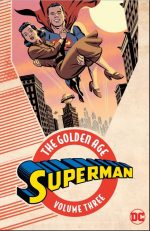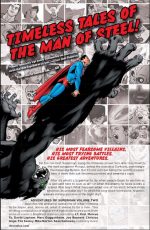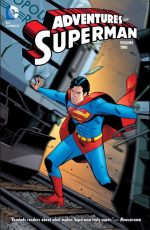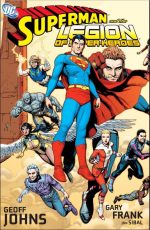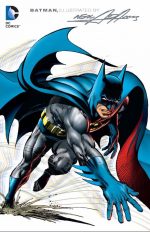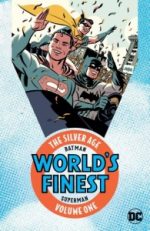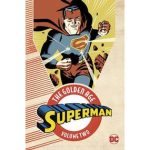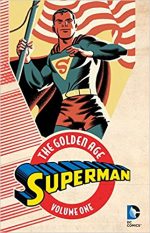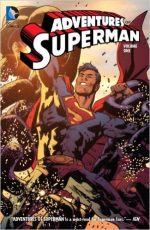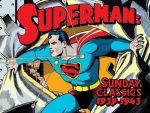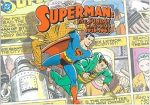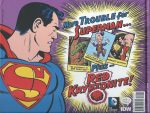
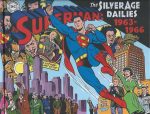
By Jerry Siegel & Wayne Boring (IDW Publishing Library of American Comics)
ISBN: 978-1-6134-0179-4
It’s indisputable that the American comicbook industry – if it existed at all – would have been an utterly unrecognisable thing without Superman. Jerry Siegel & Joe Shuster’s unprecedented invention was fervidly adopted by a desperate and joy-starved generation and quite literally gave birth to a genre if not an actual art form.
Spawning an impossible army of imitators and variations within three years of his 1938 debut, the intoxicating blend of breakneck, breathtaking action and wish-fulfilment which epitomised the early Man of Steel grew to encompass cops-and-robbers crime-busting, socially reforming dramas, science fiction, fantasy, whimsical comedy and, once the war in Europe and the East affected America, patriotic relevance for a host of gods, heroes and monsters, all dedicated to profit through exuberant, eye-popping excess and vigorous dashing derring-do.
In comicbook terms Superman was master of the world. Moreover, whilst transforming the shape of the fledgling funnybook industry, the Man of Tomorrow relentlessly expanded into all areas of the entertainment media. Although we all think of the Cleveland boys’ iconic invention as the epitome and acme of comicbook creation, the truth is that very soon after his debut in Action Comics #1, the Man of Steel became a fictional multimedia monolith in the same league as Popeye, Tarzan, Sherlock Holmes and Mickey Mouse.
We parochial and possessive comics fans too often regard our purest and most powerful icons in purely graphic narrative terms, but the likes of Batman, Spider-Man, X-Men, Avengers and their hyperkinetic kind long ago outgrew their four-colour origins and are now fully mythologized modern media creatures instantly familiar in mass markets, across all platforms and age ranges…
Far more people have seen or heard an actor as Superman than have ever read his comicbooks. The globally syndicated newspaper strips alone reached untold millions, and by the time his 20th anniversary rolled around at the very start of what we know as the Silver Age of Comics, Superman had been a thrice-weekly radio serial regular and starred in a series of astounding animated cartoons, two films, a TV series and a novel by George Lowther.
He was a perennial sure-fire success for toy, game, puzzle and apparel manufacturers and had just ended that first smash live-action television presence. In his future were three more shows (Superboy, Lois & Clark and Smallville), a stage musical, a blockbuster movie franchise and an almost seamless succession of games, bubblegum cards and TV cartoons beginning with The New Adventures of Superman in 1966 and continuing ever since. Even his superdog Krypto got in on the small-screen act…
Although pretty much a spent force these days, for the majority of the last century the newspaper comic strip was the Holy Grail that all American cartoonists and graphic narrative storytellers hungered for. Syndicated across the country – and often the planet – it was seen by millions, if not billions, of readers and generally accepted as a more mature and sophisticated form of literature than comic-books. It also paid better.
And rightly so: some of the most enduring and entertaining characters and concepts of all time were created to lure readers from one particular paper to another and many of them grew to be part of a global culture.
Mutt and Jeff, Flash Gordon, Dick Tracy, Buck Rogers, Charlie Brown and so many more escaped their humble tawdry newsprint origins to become meta-real: existing in the minds of earthlings from Albuquerque to Zanzibar.
Most of them still do…
So it was always something of a risky double-edged sword when a comicbook character became so popular that it swam against the tide (after all weren’t the funny-books invented just to reprint the strips in cheap accessible form?) to became a genuinely mass-entertainment syndicated serial strip.
Superman was the first original comicbook character to make that leap – about six months after as he exploded out of Action Comics – but only a few have ever successfully followed. Wonder Woman, Batman (eventually) and groundbreaking teen icon Archie Andrews made the jump in the 1940s and only a handful like Spider-Man, Howard the Duck and Conan the Barbarian have done so since.
The daily Superman newspaper comic strip launched on 16th January 1939, supplemented by a full-colour Sunday page from November 5th of that year. Originally crafted by such luminaries as Siegel & Shuster and their studio (Paul Cassidy, Leo Nowak, Dennis Neville, John Sikela, Ed Dobrotka, Paul J. Lauretta & Wayne Boring) the mammoth task soon required the additional talents of Jack Burnley and writers like Whitney Ellsworth, Jack Schiff & Alvin Schwartz.
As seen in this volume, the McClure Syndicate daily feature ran continuously until April 1966, appearing at its peak in more than 300 daily and 90 Sunday newspapers, boasting a combined readership of more than 20 million. Over the course of the 1950s and 1960s artists Win Mortimer and Curt Swan had occasionally substituted for the unflagging Boring & Stan Kaye, whilst Siegel provided the lion’s share of stories, telling serial tales largely separate and divorced from comicbook continuity throughout years when superheroes were scarcely seen.
Then in 1956 Julie Schwartz kicked off the Silver Age with a new Flash in Showcase #4 and before long costumed crusaders began returning en masse to thrill a new generation. As the trend grew, many publishers began to cautiously dabble with the mystery man tradition and Superman’s newspaper strip began to slowly adapt: drawing closer to the revolution on the comicbook pages.
As Jet-Age gave way to Space-Age, the Last Son of Krypton was a comfortably familiar icon of domestic modern America: particularly in the constantly evolving, ever-more dramatic and imaginative comicbook stories which had received such a terrific creative boost when superheroes began to proliferate once more. The franchise had actually been cautiously expanding since 1954, and in 1961 the Caped Kryptonian could be seen not only in Golden Age survivors Action Comics, Superman, Adventure Comics, World’s Finest Comics and Superboy but also in Superman’s Pal Jimmy Olsen, Superman’s Girlfriend Lois Lane and Justice League of America.
Such increased attention naturally filtered through to the far more widely-read newspaper strip and resulted in a rather strange and commercially sound evolution…
This third and final expansive hardback collection (spanning November 25th 1963 to its end on April 9th 1966) opens with a detailed Introduction from Sidney Friedfertig, disclosing the provenance of the strips; how and why Jerry Siegel was tasked with repurposing recently used and soon to be published scripts from the comicbooks; making them into daily 3-and-4 panel black-&-white continuities for the apparently more sophisticated and discerning newspaper audiences.
It also offers a much-needed appreciation of the author’s unique gifts and contributions…
If you’re a veteran comicbook fan, don’t be fooled: the tales “retold†here at first might seem familiar but they are not rehashes: they’re variations and deviations on an idea for audiences seen as completely separate from the kids who bought comicbooks. Even if you are familiar with the traditional source material, the adventures collected here will read as brand new, especially as they are gloriously illustrated by Wayne Boring at the peak of his illustrative powers.
After a few years away from the feature, Boring had returned to replace his replacement Curt Swan at the end of 1961, regaining the position of premiere Superman illustrator to see the series to its demise. Moreover, as the strip drew to a close many strip adaptations began appearing prior to the “debut†appearances in the comics…
As an added bonus, the covers of the issues these adapted stories came from have been included as a full, nostalgia-inducing colour gallery…
Siegel & Boring’s astounding everyday entertainments commence with Episode #145 ‘The Great Baroni’ (from November 25th to September 14th 1963), revealing how the Caped Kryptonian helped an aging stage conjuror regain his confidence and prowess: based on a yarn by Siegel & Al Plastino from Superboy #107 (which had a September 1963 cover-date).
‘The Man Who Stole Superman’s Secret Life’ (December 16th 1963 to 1st February 1964 and first seen in Superman #169, May 1964, by Siegel & Plastino) was a popularly demanded sequel to a tale where the Man of Tomorrow lost his memory and powers but fell in love.
When his Kryptonian abilities returned he returned to his regular life, unaware that he had left heartbroken Sally Selwyn behind. She thought her adored Jim White had died…
Now as Clark investigated a crook who was a perfect double for Superman he stumbled into Sally and a potentially devastating problem…
Episode #147 – running from February 3rd to March 9th – saw the impossible come true as ‘Lex Luthor, Daily Planet Editor’ (by Leo Dorfman, Swan & George Klein from Superman #168 April 1964) reveals how the criminal genius fled to 1906 and landed the job of running a prestigious San Francisco newspaper… until a certain Man of Tomorrow tracks him down…
March 9th saw Clark, Jimmy Olsen and Lois Lane begin ‘The Death March’ (originally an Edmond Hamilton & Plastino tale from Jimmy Olsen #76, April 1964): a historical recreation which turned agonisingly real after boss Perry White seemingly had a breakdown. Of course, all was not as it seemed…
‘The Superman of 800 Years Ago’ has a lengthy pedigree. It ran in newspapers from April 6th to May 18th but was adapted from the unattributed, George Papp illustrated story ‘The Superboy of 800 Years Ago’ as seen in Superboy #113 (June 1964) which was in turn based upon an earlier story limned by Swan & Creig Flessel from Superboy #17 at the end of 1951.
Here a robotic Superman double is unearthed at a castle in Ruritanian kingdom Vulcania, and our inquisitive hero time-travelled back to the source to find oppressed people and a very familiar inventor. Suitably scotching the plans of a usurping scoundrel, he left a clockwork champion to defend democracy in the postage stamp feudal fiefdom…
‘Superman’s Sacrifice’ was the 150th daily strip, running from May 18th to June 20th (adapted from a Dorfman & Plastino thriller first seen in Superman #171, August 1964). Here the Man of Steel is blackmailed by advanced alien gambling addicts Rokk and Sorban. They want to wager on whether Superman will kill an innocent. If he doesn’t they will obliterate Earth. The callous extraterrestrials seem to have all the bases covered and, even when the Metropolis Marvel thinks he’s outsmarted them, Rokk and Sorban have an ace in the hole…
It was followed by another tale from the same issue wherein Hamilton & Plastino first described ‘The Nightmare Ordeal of Superman’ (June 22nd to July 25th) wherein the Man of Tomorrow voyages to another solar system just as its power-bestowing yellow sun novas into red. Deprived of his mighty powers our hero must survive a primitive world, light-years from home, battling cavemen and monsters until rescue comes in a most unlikely fashion…
The author of ‘Lois Lane’s Love Trap’ was unattributed but the tale was drawn by Kurt Schaffenberger when seen in Superman’s Girlfriend Lois Lane # 52 (October 1964). As reinterpreted here by Siegel& Boring from July 27th to August 22nd however, it tells how Lois and Clark travel to the rural backwoods to play doctor and cupid for diffident lovers, after which August 24th to October 10th offered ‘Clark Kent’s Incredible Delusions’ (seen in comicbooks in Superman #174, January 1965 by Hamilton, Swan, Plastino & Klein).
Incredible incidents begin after a visitor to the Daily Planet casually reveals he is secretly Superman. Not only does he have the powers and costume, but Clark cannot summon his own abilities to challenge the newcomer. Can Kent have been hallucinating for years? The real answer is far more complex and confusing…
A tip of the hat to a popular TV show follows as a deranged actor trapped in a gangster role kidnaps Lois and her journalistic rival, determined to prove her companion is a mobster and ‘The “Untouchable†Clark Kent’ (October 12th November 7th): a smart caper transformed by Siegel from a yarn by Dorfman, Swan & Klein from Superman #173 November 1964.
‘The Coward of Steel’ (Siegel & Plastino, Action Comics #322, March 1965) ran from November 9th – December 19th, revealing how Superman’s pipsqueak act became all-consuming actuality after aliens ambushed the hero with a fear ray.
The year changed as Lois went undercover to catch a killer in ‘The Fingergirl of Death’ (Superman’s Girlfriend Lois Lane # 55 by Otto Binder & Schaffenberger; February 1965), reinterpreted here by Siegel& Boring from December 21st 1964 to January 23rd.
‘Clark Kent in the Big House’ – January 25th – March 6th – was seen in Action #323 April 1965 by Binder & Plastino and found Clark in a similar situation: covertly infiltrating a prison to get the goods on an inmate. Sadly once he’s there the warden has an accident and nobody seems to recognise that Kent is anything other than a crook getting his just deserts…
There was more of the same in ‘The Goofy Superman’ which ran March 8th to April 12th, taken from Robert Bernstein & Plastino’s tale from Superman #163; August 1963. This time though, Red Kryptonite briefly made Clark certifiably insane. After he was committed and got better, he stuck around to clear up a few malpractices and injustices at the asylum before heading home…
A different K meteor caused extremely selective amnesia and ‘When Superman Lost His Memory’ from April 14th to May 22nd (originally by Dorfman, Swan & Klein from Superman #178 July 1965) the mystified Man of Steel had to track down his own forgotten alter ego…
‘Superman’s Hands of Doom’ was the 160th strip saga, running from May 24th through June 26th, adapted from a Dorfman & Plastino thriller in Action #328 (September 1965). It detailed the cruelly convoluted plans of big-shot crook Mr. Gimmick who tried to turn Superman into an atomic booby trap primed to obliterate Metropolis, after which a scheming new reporter started using dirty tricks to make her mark at the Planet, landing ‘The Super Scoops of Morna Vine’ (June 28th – August 21st) through duplicity, spying, cheating and worse in a sobering tear-jerker first conceived and executed by Dorfman, Swan & Klein from Superman #181, November 1965.
The comicbook version of ‘The New Lives of Superman’ – by Siegel, Swan & Klein – didn’t appear until Superman #182 in January 1966, but the Boring version (such an unfair name for this brilliant artist!) ran in papers from August 23rd – October 16th 1965: detailing how Clark Kent had an accident which would leave any other man permanently blind.
Not being ordinary, Superman had to find another secret identity and hilariously tried out being a butler and disc jockey before finding a way for Clark to return to reporting…
Something like the truly bizarre ‘Lois Lane’s Anti-Superman Campaign’ was seen in Superman’s Girlfriend Lois Lane # 55 (Dorfman & Schaffenberger, January 1966). However, as reinterpreted by Siegel & Boring for an adult readership from October 18th to December 18th, the stunts produced for the Senatorial race between her and Superman are wild and whacky (and could never happen in real American politics No Sirree Bob!), even if 5th Dimensional pest Mr. Mxyzptlk is behind it all…
Running from December 20th 1965 through January 8th 1966, as adapted from a Dorfman & Pete Costanza thriller in Superman #185 (which eventually saw full-colour print in April 1966), ‘Superman’s Achilles Heel’ offered a slick conundrum as the Man of Might began wearing a steel box on his hand after losing his invulnerability in one small area of his Kryptonian frame.
The entire underworld tried to get past that shield but nobody really thought the problem through…
The end of the hallowed strip series was fast approaching but it was business as usual for Siegel & Boring who exposed over January 10th to February 26th ‘The Two Ghosts of Superman’ (Binder & Plastino from Superman #186, May 1966) as the hero went after crafty criminal charlatan Mr. Seer. Fanatical fans might be keen to see the cameo here from up and coming TV superstar Batman before the curtain closes…
The era ended with another mystery. ‘From Riches to Rags’ (Dorfman & Plastino from Action Comics #337, May 1966) has Superman compulsively acting out a number of embarrassing roles – from rich man to poor man to beggar-man and so forth.
Spanning February 28th to April 9th, it depicted a hero at a complete loss until his super-memory kicked in and recalled a moment long ago when a toddler looked up into the night sky…
Superman: – The Silver Age Dailies 1963-1966 is the last of three huge (305 x 236 mm), lavish, high-end hardback collections starring the Man of Steel and a welcome addition to the superb commemorative series of Library of American Comics which has preserved and re-presented in luxurious splendour such landmark strips as Li’l Abner, Tarzan, Rip Kirby, Polly and her Pals and many of the abovementioned cartoon icons.
If you love the era or just crave simpler stories from less angst-wracked times these yarns are great comics reading, and this a book you simply must have…
Superman™ and © 2014 DC Comics. All Rights Reserved.

